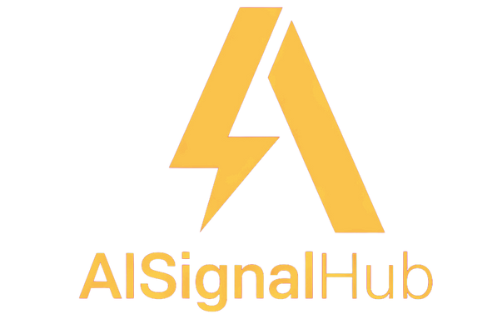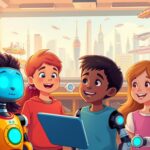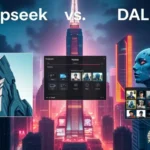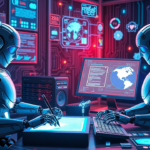Imagine a world where your child can create, innovate, and solve real-world problems with ease. Artificial intelligence is transforming education, offering kids the chance to master STEM skills through interactive and engaging tools. Today, generative AI models like ChatGPT and platforms from Google are leading this digital learning revolution.
These AI-powered solutions are designed to foster curiosity and creativity in young minds. By introducing AI thoughtfully, you can help your child develop essential skills in coding and robotics. This section sets the stage for exploring how these tools can spark interest and engagement in your child’s learning journey.
From interactive platforms to real-world projects, the opportunities are endless. Let’s dive into how AI tools are shaping the future of education and empowering the next generation of innovators.
Table of Contents
Introduction: Revolutionizing Learning with AI
Discover how AI is transforming the educational landscape, offering students innovative ways to engage with STEM concepts. From interactive platforms to real-world applications, AI is making learning more dynamic and accessible for all ages.
The Rise of AI in Education
AI-powered solutions are reshaping modern learning methods, creating interactive and personalized experiences. Prominent platforms like ChatGPT and Google experiments are leading this transformation, impacting both academic research and classroom engagement. These tools are not just for advanced learners; they’re designed to be accessible, ensuring every student can benefit.
How Technology Sparks STEM Curiosity
By integrating AI into education, we’re seeing a surge in student curiosity and engagement. Interactive tools and games make complex STEM concepts fun and approachable. Whether it’s through coding games or robotics projects, AI helps students develop essential skills in a hands-on way. This shift is creating a new generation of innovators, ready to tackle real-world challenges with creativity and confidence.
- AI is making education more engaging and accessible.
- Interactive tools spark curiosity and foster a love for STEM.
- Students of all skill levels can benefit from AI-powered learning.
Join us as we explore how AI is revolutionizing learning and empowering the next generation of thinkers and innovators.
Understanding the Impact on Child Development
Understanding how technology shapes young minds is crucial for modern parents and educators. Artificial intelligence is proving to be a powerful ally in fostering essential skills in children, making learning both fun and effective.
Boosting Problem-Solving Skills
Engaging with AI tools regularly can significantly enhance a child’s problem-solving abilities. Interactive platforms allow kids to train machine learning models, teaching them to recognize images, numbers, or sounds. These hands-on experiences make complex concepts approachable and exciting, encouraging children to think critically and develop analytical skills.
Fostering Creativity Through AI
AI also plays a key role in nurturing creativity. Projects that incorporate AI help children grasp abstract ideas in an engaging way. By prompting kids to think outside the box, AI tools inspire innovative approaches to challenges. This early stimulation of creativity and analytical thinking prepares children to thrive in a rapidly evolving technological world.
Essential AI Tools for Kids
When choosing AI tools for your child, it’s important to focus on platforms that combine education with fun. These tools should offer interactive features that keep young minds engaged while teaching valuable skills.
Key Features to Engage Young Minds
Top AI tools for kids often include features like visual recognition, interactive prompts, and game-based learning. These elements make complex concepts easy to understand and exciting to explore. For example, platforms like Scratch and Code.org use colorful interfaces and step-by-step guides to introduce coding basics.
Another key feature is the ability to build and test AI models. Tools like Machine Learning for Kids allow children to create models that recognize images and text, providing hands-on experience with AI concepts.
Comparing Top Platforms and Applications
Google’s AI Experiments and ChatGPT are popular choices, each offering unique strengths. Google’s platform focuses on interactive projects that explore AI concepts without requiring coding skills. ChatGPT, while more advanced, provides conversational learning that can simplify complex topics for students.
When evaluating these options, consider factors like functionality, cost, and ease of use. Some platforms are free and perfect for beginners, while others offer premium features for more advanced learners. The goal is to find a tool that matches your child’s skill level and learning style.
By exploring these tools, you can help your child discover the exciting world of AI and coding, setting them up for success in a technology-driven future.
Coding and Robotics: A Fun Journey
Coding and robotics are not just about technology—they’re about creativity, problem-solving, and innovation. For kids, these subjects can be a gateway to a world of exploration and discovery. By combining learning with fun, interactive platforms and hands-on projects, you can help your child develop essential skills while sparking their curiosity about AI for Kids .
Interactive Coding Platforms for Beginners
Interactive coding platforms are designed to make learning fun and engaging. Platforms like Scratch and mBlock use colorful interfaces and drag-and-drop functionality to introduce kids to coding basics. These tools allow students to create games, animations, and stories, making the learning process both enjoyable and rewarding for AI for Kids .
For example, mBlock introduces advanced AI concepts like speech and face recognition, helping kids grasp complex ideas in an interactive way. These platforms are perfect for beginners, as they provide step-by-step guides and immediate feedback, allowing young learners to progress at their own pace while exploring AI for Kids .
Robotics Projects that Inspire Innovation
Robotics projects offer a hands-on way for kids to learn about technology and innovation. DIY projects, such as building and programming simple robots, provide a tangible way to understand coding logic and problem-solving. For instance, the mBot kit includes components like motors and sensors, enabling kids to create and test their own robotic creations inspired by AI for Kids principles.
These activities promote both logical reasoning and creative expression. By working on robotics projects, kids develop critical thinking skills while bringing their ideas to life. Such experiences not only make learning fun but also prepare them for future challenges in a technology-driven world, all while aligning with the core values of AI for Kids .
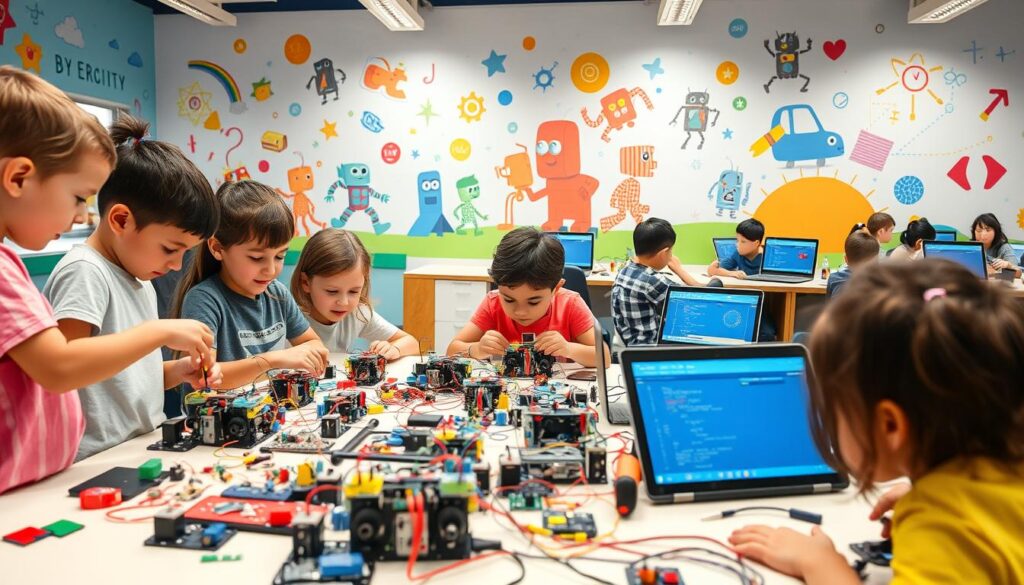
Encourage your child to explore these interactive platforms and robotics projects. They offer a fun and educational way to develop essential skills, setting them up for success in a rapidly changing world.
Essential AI Tools for Kids in School and Home Learning
As education evolves, integrating advanced technologies like AI into both school and home environments becomes essential for fostering a well-rounded learning experience. Parents and educators are increasingly exploring how to effectively incorporate these tools to support student development.
Practical Strategies for Parents and Educators
Educators can enhance traditional teaching methods by incorporating AI Tools for Kids into their resources. For instance, interactive platforms like Google’s AI Experiments can make complex STEM concepts more engaging. These tools offer hands-on experiences, allowing students to explore topics in a dynamic way.
Parents play a crucial role in guiding their children’s use of AI-driven educational apps. Setting clear boundaries and encouraging open discussions about the role of AI Tools for Kids in learning can help kids use these tools responsibly. Parents should also explore free resources that enrich the learning environment without additional costs.
This version integrates the focus keyword “AI Tools for Kids” naturally while keeping changes minimal and maintaining the original meaning.
Key Strategies for Effective Integration:
- Encourage a balanced approach by combining digital learning with hands-on activities to support overall development.
- Utilize free AI resources like TeacherServer, which offers over 640 tools for educators, to enhance lesson plans.
- Focus on platforms that provide immediate feedback, such as Machine Learning for Kids, to aid in understanding complex concepts.
By thoughtfully integrating AI into daily learning routines, parents and educators can create engaging and effective environments that prepare students for future challenges.
Exploring Advanced AI Learning Resources
As your child gains confidence in basic coding and robotics, it’s time to explore advanced AI learning resources. These tools offer real-world applications that challenge and engage students, preparing them for future tech challenges.
Diving Into Projects and Real-World Applications
Advanced AI tools let students tackle complex projects, blending creativity with problem-solving. These resources are designed to deepen understanding and application of AI concepts.
- Google’s AI Experiments offer interactive projects that let students explore AI without coding, making advanced concepts accessible.
- Scratch extends beyond basics with AI integrations, allowing students to create sophisticated projects like voice-activated games.
- Code.org provides advanced courses where students can develop AI-driven solutions for real-world issues like environmental monitoring.
These platforms build on foundational skills, fostering advanced problem-solving and critical thinking. They prepare students to innovate and lead in a tech-driven world.
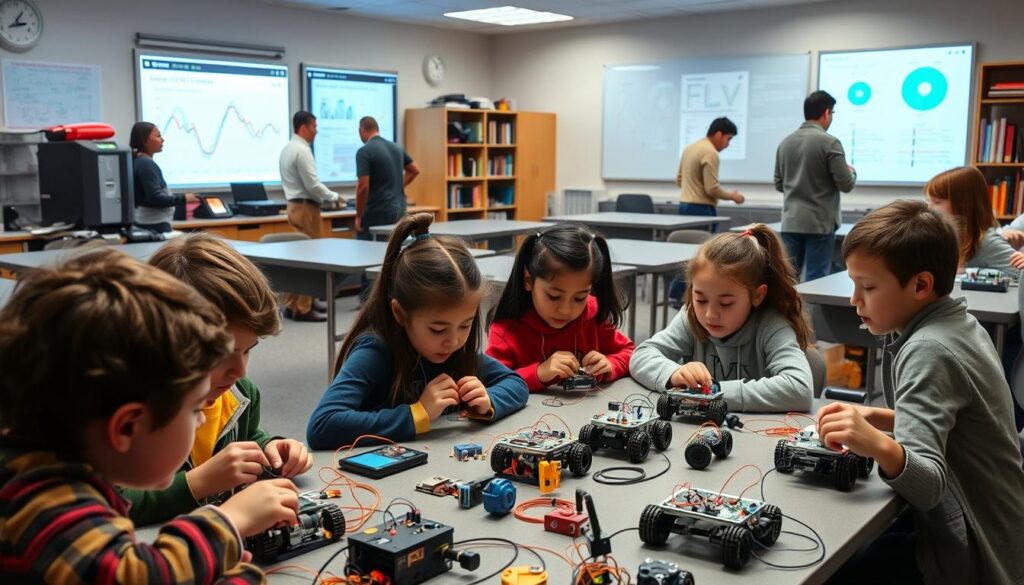
Encourage your child to explore these resources. They offer a pathway to future success, blending education with exciting, real-world applications.
Practical Tips for Daily AI Engagement
Helping your child navigate the world of AI can be both fun and educational. Balancing digital learning with hands-on activities ensures a well-rounded experience.
Balancing Digital Learning and Hands-On Play
Digital tools like Google’s interactive games can engage students, but it’s important to mix this with physical activities. This balance enhances creativity and retention.
- Schedule AI sessions followed by art or building projects to keep things varied.
- Use free platforms like Machine Learning for Kids for interactive learning.
- Encourage outdoor activities or crafts after screen time to maintain balance.
By combining digital and physical learning, you create an engaging routine that fosters growth and innovation.
Conclusion
As you explore the world of AI Tools for Kids , remember that these tools are designed to enhance your child’s educational journey. From interactive coding platforms to innovative robotics projects, these resources foster problem-solving, creativity, and practical skills essential for the future.
This guide has walked you through selecting the best tools and strategies, ensuring your child gains the most from their learning experience. By integrating AI Tools for Kids into both school and home environments, you create a balanced approach that supports overall development.
Encourage your child to embrace these technologies thoughtfully. Make AI a natural part of their learning world, where they can grow into curious, innovative thinkers. The future is full of possibilities, and with the right tools, your child can lead the way.
FAQ
How can AI tools make learning more engaging for students?
What should I look for when choosing an AI tool for my child?
Can AI tools help improve my child’s problem-solving skills?
How do AI tools foster creativity in learning?
Are there AI tools suitable for children who are just starting to code?
How can parents and educators effectively use AI tools in education?
What advanced AI resources can help older students with projects?
How can I ensure my child uses AI tools productively?
Source Links
- Machine Learning for Kids: Elevate Your Child’s Genius 2025 – https://www.jetlearn.com/blog/empower-machine-learning-for-kids
- Best Interactive AI Learning Tools for Kids: Top Apps and Platforms to Get Started – https://codeyoung.com/blog/best-interactive-ai-learning-tools-for-kids-top-apps-and-platforms-to-get-started-cm5ay0wz900za3acequ0m968b
- Revolutionizing Education – https://medium.com/educreation/revolutionizing-education-1b8b2efe9ade
- Exploring AI for Kids: A Comprehensive Beginner’s Guide | CodaKid – https://codakid.com/blog/introduction-to-artificial-intelligence-for-kids/
- AI In Education: Revolutionizing Learning And Training For Students In 2024 – https://coggno.com/blog/ai-in-education/
- The Future of Artificial Intelligence in Early Childhood: Transforming the Field for Professionals and Children – https://www.zerotothree.org/resource/the-future-of-artificial-intelligence-in-early-childhood-transforming-the-field-for-professionals-and-children/
- The Impact of AI on Children’s Development – https://www.gse.harvard.edu/ideas/edcast/24/10/impact-ai-childrens-development
- AI’s Impact on Kids: Benefits & Risks | Mobicip – https://www.mobicip.com/blog/ai-kids-online-benefits-risks
- AI for Kids: 10 Websites Your Child Can Easily Learn AI and Machine Learning — Greensprings School – https://www.greenspringsschool.com/ai-for-kids/
- AI for kids: 5 fun ways to introduce children to generative AI – https://www.qustodio.com/en/blog/ai-for-kids/
- 10 Best AI Tools For Kids [ 2025] – https://buddyxtheme.com/best-ai-tools-for-kids/
- AI and Robotics for Kids: Learn Coding and Build Robots with mBot – https://skoolofcode.us/blog/ai-and-robotics-for-kids-the-joy-of-building-and-coding-robots-with-mbot/
- Top 10 Affordable AI Robots for Kids to Learn Coding and AI | CodaKid – https://codakid.com/blog/top-10-affordable-ai-robots-to-teach-kids-coding-and-ai/
- AI For Kids – https://www.codingal.com/coding-for-kids/blog/ai-for-kids/
- AI Tools in Teaching and Learning – https://teachingcommons.stanford.edu/news/ai-tools-teaching-and-learning
- Curious how teachers use AI in the classroom, professor creates popular online platform to enhance learning – https://www.stpetersburg.usf.edu/news/2024/professor-creates-popular-online-ai-platform.aspx
- The role of AI in modern education – https://onlineprograms.education.uiowa.edu/blog/role-of-ai-in-modern-education
- Top Interactive AI Learning Tools for Kids: Engaging Apps and Platforms | CodaKid – https://codakid.com/blog/interactive-ai-learning-tools-for-kids/
- Artificial intelligence projects for kids | AI projects | ML – https://www.raspberrypi.org/blog/artificial-intelligence-projects-for-kids/
- How Kids Can Build AI-Powered Apps | Codingal – https://www.codingal.com/coding-for-kids/blog/how-kids-can-build-ai-powered-apps/
- AI Tools for Kids: How to Enhance Learning and Engagement – https://writingmate.ai/blog/ai-tools-for-kids
- Using AI to Fuel Engagement and Active Learning – https://www.ascd.org/el/articles/using-ai-to-fuel-engagement-and-active-learning
- A Student Perspective – University Center for Teaching and Learning – https://teaching.pitt.edu/resources/tips-to-level-the-ai-playing-field-in-the-classroom-a-student-perspective/
- Is Artificial Intelligence Good for Society? – https://www.timeforkids.com/g56/is-ai-good-for-society-g5/
- Learn how to help your kids use AI responsibly to boost learning and creativity. – https://www.nordangliaeducation.com/wps-florida/news/2024/09/27/how-your-kids-can-use-the-power-of-ai-without-compromising-learning
